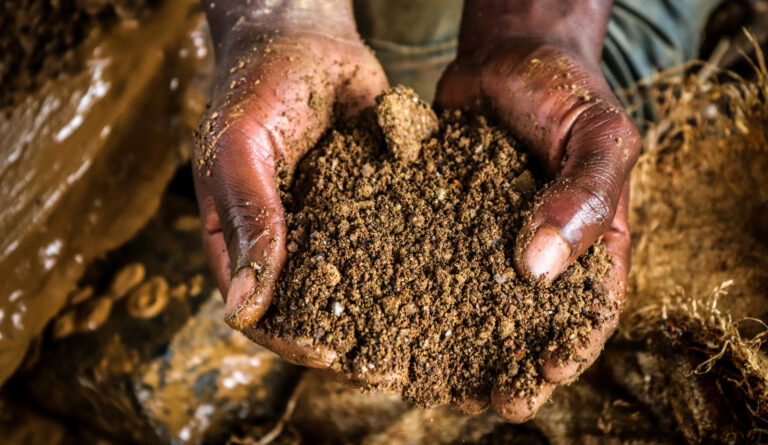From March 19 to 30, 2012, Frédéric Triest, permanent member of Justice and Peace, went on a mission to the Democratic Republic of Congo (DRC). He met various civil society actors in Bukavu, Goma and Kinshasa working on the management and impacts of the artisanal mining sector. The opportunity for Justice and Peace to take stock of the situation in this vital sector for the economy and reconstruction in the East, as well as for the establishment of lasting peace in the Region, and to propose some avenues action from Belgium and Europe.
Attachments
Notes[+]
| ↑1 | World Bank, The Democratic Republic of Congo: good governance in the mining sector as a factor of growth, May 2008, p.63. |
|---|---|
| ↑2 | M. Mazalto, “Reform of the mining sector in the Democratic Republic of Congo: governance issues and reconstruction prospects”, in Afrique contemporain, n°227, 2008/3, p.65. |
| ↑3 | “Coltan” is the nickname given by the Congolese to columbo-tantalite. After sieving and refining, what remains is tantalum which is an excellent conductor of electricity, easily malleable and very resistant to corrosion and heat. Although currently only 5% to 10% of world production comes from DR Congo – in the east, the Kivu provinces – Africa is said to have more than 60% of world reserves and that Kivu coltan contains the one of the highest levels of tantalum in the world. |
| ↑4 | Didier de Failly, “Coltan: to understand…”, in L'Afrique des Grands Lacs, directory 2000-2001, Center for the Study of the Great Lakes Region, Antwerp, L'Harmattan, p. 281-306. |
| ↑5 | Frank Mayundo Muyuba, Mining in South Kivu: the responsibility of companies and the State, University of CEPROMAD Bukavu/Sud-Kivu/RD, 2006. |
| ↑6 | Aloys Tegera, “Coltan explained to my son”, in Regards Croissants, n°30 bis, Pole Institue, Goma, October 2011, p.64-67. |
| ↑7 | International Alert, Study on the role of the exploitation of natural resources in fueling and perpetuating crises in Eastern DRC, London, October 2009. |
| ↑8 | Ibidem, p.64. |
| ↑9 | US Dodd Frank Wall Street Reform and Consumer Protection Act |
| ↑10 | The ICGLR is an intergovernmental process established in 2004 involving eleven States of the African Great Lakes and aimed at establishing peace in the Region. In June 2008, it promulgated a “Protocol on the fight against the illegal exploitation of natural resources”. |
| ↑11 | Didier Verbruggen, Evie Francq and Jeroen Cuvelier, Guide to Current Mining Reform Initiatives in Eastern DRC, International Peace Information Service (IPIS), Antwerp, April 2011. See also Sarah Zingg Wimmer and Filip Hilgert, Bisie. A one-year snapshot of the DRC's main cassiterite mine, International Peace Information Service (IPIS), Antwerp, November 2011. |
| ↑12 | United Nations Group of Experts on the Democratic Republic of Congo, Final Report 2011, United Nations Security Council, December 2011, p.37-40. |
| ↑13 | Ibidem, p.51-52. |
| ↑14 | United Nations Group of Experts on the Democratic Republic of Congo, op. cit., p.51-52. |
| ↑15 | Catholic Relief Service (CRS) and Episcopal Commission for Natural Resources (CERN), Study of needs. Mining communities of Luttwinja, Mukungwe, Ninja and Nzibira (South Kivu – DRC), October 2011. |
| ↑16 | Some censuses show 13,000 people. The exact figure would be around 6,000. |
| ↑17 | Sarah Zingg Wimmer and Filip Hilgert, op. quote.. |
| ↑18 | See in particular, Didier Verbruggen, Evie Francq and Jeroen Cuvelier, op. quote.. |
| ↑19 | Global Witness, The future of the Congolese mineral trade hangs in the balance: opportunities and obstacles associated with demilitarization, May 18, 2011, see: p.6-7. |
| ↑20 | GESI is an organization made up of private information and communications companies, dedicated to promoting the sustainability of information and communications technologies. |
| ↑21 | The EICC is another organization of private companies in the electronics and information and communications technology sectors. It promotes an industry code of conduct for global supply chains that improve working and environmental conditions. |
| ↑22 | “OECD Guidance for Responsible Supply Chains for Minerals from Conflict or High-Risk Areas.” |
| ↑23 | See http://www.flexicadastre.com/drcmapportal/. See http://www.congomines.org/map/. |
| ↑24 | See http://www.gecoproject.org/. |
| ↑25 | See http://www.ipisresearch.be/mapping |
| ↑26 | See previously “Chaotic implementation of initiatives dedicated to the formalization of the artisanal sector”. |
| ↑27 | See previously “Chaotic implementation of initiatives dedicated to the formalization of the artisanal sector”. |





